#sometimes i think that we just live in an old point-and-click adventure game & succeed in accidental combining things that seem incompatible
Text
My husband, showing me a small bottle of Jägermeister: I think I found what to add to our coffee.
Me: Are you sure that coffee with milk and Jägermeister is a good idea?
Husband: Yup. What's wrong?
Me: Milk, mostly. I suppose Jägermeister won't taste good with milk.
Husband: Why?
Me: Well, Jägermeister is made from herbs...
Husband, with an absolutely straight face: As well as milk. From herbs and cows!
Me: ...
Me: ...unarguable. 🤣
He also added some pear syrup to it. Don't know why, but in the end that crazy mix got banana flavor. It tasted really good.
Good Tuesday morning, everyone. :D
#sometimes i think that we just live in an old point-and-click adventure game & succeed in accidental combining things that seem incompatible#does it even count as a morning if i haven't slept yet?#oh nevermind x))#me and my husband#iron logic :D#jägermeister#coffee
11 notes
·
View notes
Photo


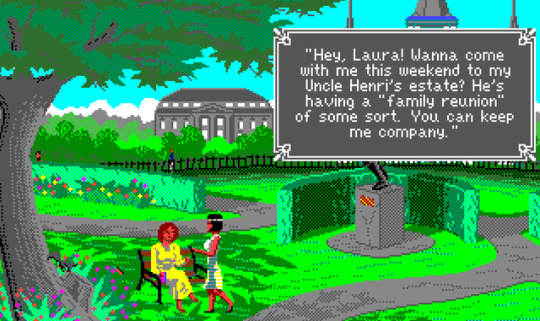

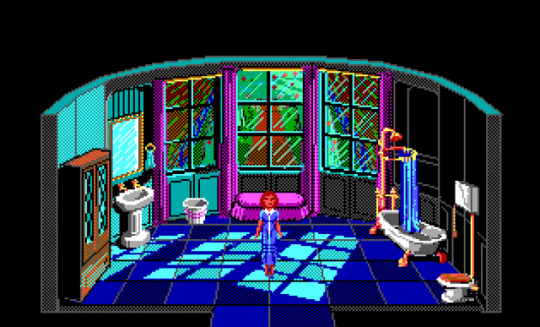


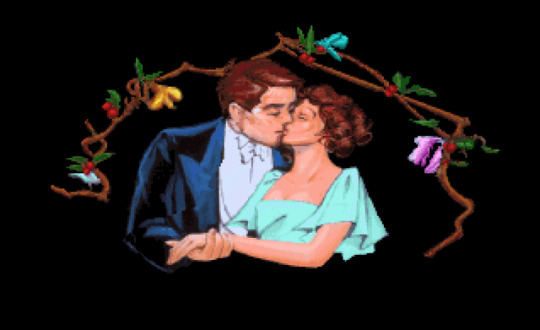


The deductive point ‘n click escapades of a forgotten southern belle
Adventure games of the point ‘n click variety are a genre that tend to feature female protagonists more often than others. Why this is the case, I’m not entirely sure - it might have something to do with the stereotype that women are more patient, more willing to read and perhaps better at solving puzzles than men. Or, perhaps legendary adventure game designer Roberta Williams’ influence still holds strong, at least on a subconscious level in the minds of designers, over the genre that she helped nourish in the 80s and 90s, and the heroines of today’s games are merely following in the footsteps of fine women that preceded them, like Rosella of Daventry in King’s Quest IV.
Whatever the reason, despite there being quite a few point ‘n clickers popping up these days with engaging female protagonists (Kathy Rain is one that I played early this year and enjoyed), there’s a 1920s southern belle who probably deserved a long-lasting series but only got two games which are somewhat overlooked these days. Her name is Laura Bow, and she served as the protagonist of two Sierra titles that were released in 1989 and 1992 - The Colonel’s Bequest and The Dagger of Amon Ra.
Laura seems to have been specifically patterned after famous silent film actress Clara Bow, but at her heart she’s more like a slightly older version of Nancy Drew, and her two games embody Nancy’s fine tradition of mystery solving. The Colonel’s Bequest takes place on a private island in the bayous of New Orleans as Laura accompanies a friend and fellow Tulane University student for a weekend getaway at the manor of her uncle, Colonel Dijon. The old man is bequeathing his fortune to relatives and has invited a motley assortment of characters right out of an Agatha Christie paperback - the drunk aunt, the conceited Hollywood starlet, the perverted doctor who seems to have a thing for betting on the ponies - and a la Clue, bodies start piling up as the relatives presumably begin offing themselves in order to get Dijon’s fortune first.
I mentioned Roberta Williams previously, and The Colonel’s Bequest was actually designed by her as one of those rare side projects that didn’t feature the words “King’s” and “Quest” in the title. (Hm, I suppose it’s called The Colonel’s Bequest, so scratch that.) It’s always hard to tell how much Roberta was involved in non-King’s Quest projects - The Dagger of Amon Ra, for instance, was directed by Bruce Balfour despite featuring her name on the box - but I’d wager that she intended The Colonel’s Bequest to be a spiritual remake of her very first adventure game (and indeed, the first graphical adventure game ever), Mystery House. Mystery House featured a similar murder plot, and The Colonel’s Bequest takes this concept and evolves it, offering a unique structure where there aren’t really any puzzles to solve but instead “scenes” to witness. The entire game is structured like a play - there’s even a cast curtain call in the beginning - and Laura is encouraged to spend as much time as possible talking with the potential murder suspects and finding unique ways to eavesdrop on them.
The game’s manual makes a huge deal about this emphasis on observing the story and slowly figuring out the links between characters in an effort to deduce the killer, and we can look at Johnny L. Wilson’s 1990 review of the game in Computer Gaming World as an example of how this approach was seen as admirable, fresh and also a bit risky at the time. Don’t let the fact that there aren’t many puzzles fool you into thinking that The Colonel’s Bequest is easy, though - it’s just as tough as Sierra’s other adventures with just as many nonsensical ways to die, and the unique structure where certain events and conversations are “timed” (indicated on screen by a clock) means that sometimes you’ll be wandering around aimlessly searching for the next thing to do, or possibly miss out on vital bits of info because you weren’t at the right place at the right time. It’s a little like The Last Express, only less refined.
Luckily, the game’s great atmosphere makes up for any shortcomings that its boldly unorthodox but occasionally clunky design creates. This is one of the best 16 color titles that Sierra produced with their SC10 engine, and the soundtrack is packed with jazzy songs influenced by the Roaring Twenties with just enough sense to know when to be quiet as well. As you navigate Laura across the silent grounds of the mansion in the dead of night, wondering where the killer might be, it’s very possible to get shaken by the sound of lightning bursting in the background, and I can certainly imagine young players in 1989 jumping out of their skin when they encountered such moments.
Laura’s next outing, The Dagger of Amon Ra, trades the dark island setting for the Egyptology craze of the 20s, and loses a little bit in the process but makes up for it with 256 colors, rotoscoped animations (which are darn smooth but cause character sprites to be a bit muddy, unfortunately) and an even catchier selection of jazz tunes, including an amusing vocal track called “The Archaeologist Song.” Oh, and the CD version is a “talkie” game, with performances that range from kinda terrible (Sierra was still having their employees voice these games at the time instead of hiring actors) to excellent (Laura’s got a cute southern accent and the narrator’s voice is heavenly).
The plot revolves around the titular Dagger of Amon Ra, an Egyptian artifact that’s been stolen from a New York City museum. Laura, now a fresh grad from Tulane and in the middle of her first journalism assignment at an NYC paper, has to navigate the mean streets of Manhattan, infiltrate a speakeasy and chat with a mildly racist caricature of a Chinese laundromat owner before getting into the museum, where she once again encounters a wide cast of characters, from the stuck up British twat who removed the dagger from Egypt to the nutty countess, who is possibly engaged in some mild robbery efforts around the museum when nobody’s looking. People start dying pretty soon (and their death scenes are grand - check out this poor SOB who got decapitated and stuck with a Perodactyl beak) and while the beginning section of the game outside of the museum is more like a traditional point ‘n click affair, once you’re locked inside the building after the first murder, everything becomes reminiscent of The Colonel’s Bequest. You’ve got to meander about, hope you bumble upon the right conversations and try your best to piece together clues before the murderer suddenly starts chasing you during the game’s second-to-last chapter.
The Dagger of Amon Ra kind of stumbles in its execution of this form of gameplay more than its predecessor, because all the chapters of museum exploration feel terribly disjointed even more than walking around Colonel Dijon’s mansion did. Also, the character motivations are unclear, which is a problem in a mystery game - especially one where the entire final chapter actually involves Laura being quizzed by the coroner in an annoying game of 20 Questions as to the identity and motives of the killer! If you slip up once during this finale, you’ll get the bad ending, which involves the killer finding Laura’s apartment and GUNNING HER IN HER SLEEP, jinkies. And even if you succeed and get the good ending, which sees Laura writing her first award-winning expose on the theft and hooking up with putzy love interest Steve Dorian, it’s still quite impossible to discern the killer’s motives and why he went about his nefarious deeds, because The Dagger of Amon Ra just...doesn’t explain things. I’m not the only one who had trouble figuring it out - The Adventure Gamer blog wrote up a fantastic series of posts about this game and came to the same confused reaction as I did.
Both Laura Bow adventures come from an older time where it was common to take notes as you went through a game, so perhaps my puzzlement at The Dagger of Amon Ra’s ending is due to my lack of pencil and paper by my side as I played. I did use walkthroughs for both games, though, and if you do end up checking them out (they’re available on GOG), I’d recommend doing the same. You probably still won’t be able to figure out why whatshisname stole that dagger, but despite their flaws, the Laura Bow games really are worth experiencing. Laura’s a likeable lead (just look at this adorable expression on her face as she stumbles upon the museum’s French skank engaged in hanky panky with the janitor) and she does a fine job of showing off the spirit of the 20s, an underrepresented period in the pantheon of electronic gaming.
Laura never got a third game, and as far as mystery franchises go, Sierra soon passed the torch to the Gabriel Knight series, which apparently takes place in the same universe, since Gabriel visits Tulane in Sins of the Fathers and hears word of a lecture being given by “Laura Bow Dorian” - a hint that Laura married Steve Dorian and lived happily ever after! I’m glad that Ms. Bow got a nice ending even if we couldn’t see it in game form, and I’m sure that if she were a real person, she would be pleased to see spiritual successors of sorts like the aforementioned Kathy Rain following in her footsteps today.
This is perhaps a good place to mention The Crimson Diamond, an upcoming indie game in the works by Canadian illustrator Julia Minamata. I recently played through the demo and am eagerly awaiting the full release - it’s almost like a direct sequel of The Colonel’s Bequest with an alternate universe version of Laura. Rest assured, Ms. Bow - even if your adventures aren’t as remembered these days as they should be, the example you set of the enterprising female gumshoe is alive, well and in good hands!
All box art and screenshots from Mobygames.
#pixel grotto#video games#favorites#laura bow#colonels bequest#dagger of amon ra#sierra online#roberta williams
6 notes
·
View notes
Text
The Legacy of Batman: Tom King, Kevin Conroy, and Scott Snyder on the Dark Knight
https://ift.tt/2JHaNx5
This year, we talked to Tom King, Kevin Conroy, Bruce Timm, Scott Snyder, Jock, and Pete Tomasi about why Batman still matters.
facebook
twitter
tumblr
It all began with two shots in the dark, pearls spilling onto the blood-soaked cement. No, it all started when the bat crashed through the window. Actually, it was when the boy fell into the cave. Maybe it was that hostile takeover at Apex Chemicals? Dozens of stories have shaped the legend of the Batman over his 80-year history, tales that have made the Caped Crusader arguably the most iconic character in comic book history, rivaled only by Superman.
When Bill Finger and Bob Kane put pen and pencil to paper for 1939's Detective Comics #27, they had no way of knowing that they were creating a new American myth that would captivate readers and movie audiences for decades to come. They certainly didn't expect their first Batman adventure, "The Case of the Chemical Syndicate," to spawn 973 more issues of Detective Comics, let alone become a blockbuster franchise featuring movies, TV series, video games, and McDonald's Happy Meals.
But what bigger testament to the long-lasting appeal of Batman than March’s Detective Comics #1000, written and drawn by some of the best creators in the business? The giant-sized, 96-page issue featured stories by legends such as as Dennis O'Neil, Neal Adams, Steve Epting, Christopher Priest, Jim Lee, Kelley Jones, Paul Dini, Brian Michael Bendis, Warren Ellis, and Geoff Johns as well as the current custodians of the Bat-mythos -- Tom King, Tony S. Daniel, Peter J. Tomasi, Doug Mahnke, Joelle Jones, Scott Snyder, and Greg Capullo. And that's not even including the excellent covers by Jim Steranko, Bernie Wrightson, Bruce Timm, Frank Miller, Jock, Tim Sale, and more.
Batman is only the second DC superhero to reach such a massive milestone, the other being the Man of Steel. What is it about this character hellbent on avenging the death of his parents night after night that has kept him at the forefront of our pop culture?

“I think what makes him deeply enduring is that it’s a really primal folk tale,” Scott Snyder, who’s been writing Batman stories since 2011, says. “It’s a story about a boy who loses everything and turns that loss into fuel to make sure that what happened to him never happens to anybody else.”
While most of us aren't billionaire playboys with the resources to fight crime on a global (and sometimes cosmic) level, we understand pain, both emotional and physical, and a need to rise above it, even if we can't always do that. We sympathize with Bruce's biggest regret -- if only he hadn't made his parents take him to see that Zorro movie; if only he hadn't been frightened by the opera; if only he'd been braver and faster as the thug pulled the trigger. For Bruce, his crusade to stop evildoers comes down to replaying that single fateful moment over and over again and making possible a different outcome.
Yet, Batman perseveres despite all of this pain, which is why people flock to the character, according to Snyder.
"It's a story of triumph over your worst fears, worst tragedy, and about taking your loss and turning it into a win," the writer says. "There's just this kind of power to him that speaks to our own potential, the human potential, even when we're challenged by things that seem insurmountably horrible."
Snyder has spent the better part of a decade showcasing Batman as a symbol of hope for the citizens of Gotham, putting him through the ringer, reopening old wounds while also making new ones -- the writer even killed the hero off at one point -- just so that he can pick himself up again and keep fighting.
But the character isn't driven solely by tragedy. Who could hang with a downer like that for 80 years?
"There are the fun elements, of course, that are similar to James Bond, like the gadgets, and the cars, and the planes, and just the cool factor of his costume."
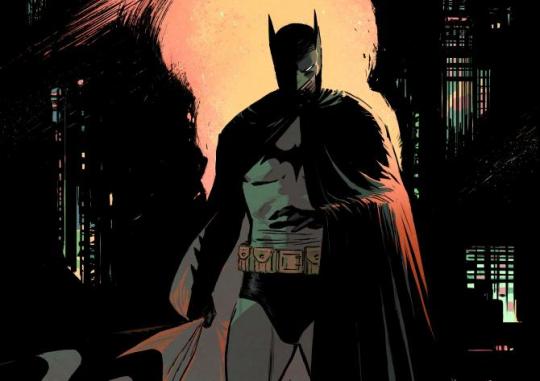
Tom King, who recently wrapped up an 85-issue run on Batman and currently has a Batman/Catwoman miniseries in the works, looks back to the character's real-life point of origin as the reason he has stood the test of time.
"You have to go back to the moment of creation with him. You've got [Bob Kane and Bill Finger], the children of immigrants, so we're like, what, 1938, '39, we're in Manhattan. And at that time, I mean, go back and look at the pictures, Batman was created like 20 blocks from Madison Square Garden where they had a Nazi rally that attracted a hundred thousand people. They were marching in the streets."
These tumultuous times shaped the fabric of Batman, according to King.
"[Kane and Finger] were living here and their literal cousins and grandparents were getting killed in Europe, right? And they created something uniquely American. Batman succeeds because there's something genuinely beautifully American about it."
According to Batman: The Animated Series voice actor Kevin Conroy, Batman’s continued popularity goes back to something primal. To the classically trained actor who was immortalized as the voice of Batman in the ‘90s cartoon, the Caped Crusader is a modern retelling of myths and stories humans have been passing down for thousands of years.
“He’s such a theatrical character,” Conroy says, admitting he was at first hesitant to audition for the role. At the time, he was a theater actor who'd never done an animated role. But when he read the script, the character clicked. Conroy recognized this story. “They were absolutely right to cast a theater actor, especially one with a classical background, because this is Shakespeare. They’re doing high drama. Batman is Achilles. He’s Orestes. He’s Hamlet.”
The tragic Greek character Orestes, in particular, was on Conroy’s mind when playing Batman. By that point, he’d performed several plays as Orestes, a son who avenges his father’s murder and goes mad because of it. By the end of the story, Orestes has gone through hell and back because of his thirst for vengeance. Naturally, Conroy brought that familiarity with Orestes to his portrayal of Batman.
“He’s a Homeric hero,” Conroy says of the Caped Crusader. “I think of it often when I’m doing Batman because Orestes is haunted by the Furies. He descends into hell. He comes back. He’s resurrected at the end, and I think so often, this is a very Orestial-like journey that Bruce Wayne goes on. His Furies are the memory of his parents’ murder. It haunts him through his life. It’s transformed him."
Conroy calls Batman a “classic character.” Like Orestes before him, Batman has become the protagonist of our very own mythology.
“He’s come out of such a fire and instead of letting life crush him, he turns that metamorphosis into something even greater than himself,” Conroy says. “They’ve been telling that story for thousands of years in different cultures, and this is our culture’s way of telling those stories, and I think they’re just as valid.”
Bruce Timm, who co-created Batman: The Animated Series and designed the show's iconic Art Deco aesthetic, is unsurprisingly most taken by Batman's look.
"I just think Batman looks great," Timm says during our chat at NYCC in 2018. "He's got the best costume motif in comics. Nothing comes close. He's dark, sexy, and broody. It's really intoxicating and compelling in a way that almost no other in comics can come close to it."
He also admires the durability of the character through the different eras of comics, from the Golden Age, to the sillier '50s and '60s stories of the Comics Code era, to the darker takes we're more accustomed to today.
"It is amazing to me how flexible he is as a character. That you could have something as silly as the Adam West show or the old '50s comics, and then you have stuff like Neal Adams and Frank Miller and what we did. And you know, even more extreme, [Grant Morrison and Dave McKean's graphic novel] Arkham Asylum and things like that. And yet their all kind of the same character. It's like that character can encompass all of those different things. He can do space aliens and serial killers, you know? Yet, it kind of works."
This flexibility has allowed plenty of writers and artists to experiment with the Dark Knight, creating different versions of the character over the years. There really isn't a definitive take on Batman. You can love the Batusi, Bat-Mite, or Mr. Freeze's cool party and still be right on the money about the Caped Crusader. You'd be remiss to call the character stale. The guy has done it all.

"It's almost like he's a force of nature, in which stories can happen around him, and there's something primordial, maybe, about the character and the way he looks, as well," says veteran Batman artist Jock, who most recently worked on a seven-part miniseries with Snyder called The Batman Who Laughs. "You could put Batman in a new pose, and he'd still flourish, and I think those kinds of characters are very rare."
Peter J. Tomasi, who is currently writing Detective Comics, puts it best:
"He's a character who can work across all genres. Somehow, someway, he can simply fit into every story, be it a war story, a western, a love story, a comedic angle, sci-fi, horror, fantasy, you name it, and of course any detective story you can possibly imagine."
Superheroes won't always be at the top of our pop culture food chain. It's inevitable that many of the characters we love today will fade with future generations, just as the Shadow, Doc Savage, Zorro, and the Scarlet Pimpernel did. Will we still be talking about Batman in another 80 years? We may eventually embrace new forms of familiar myths, becoming obsessed with new idols. But only a fool would bet against a character who's survived as long as Batman has. Remember, the Batman always wins.
John Saavedra is an associate editor at Den of Geek. Read more of his work here. Follow him on Twitter @johnsjr9 and make sure to check him out on Twitch.
facebook
twitter
tumblr
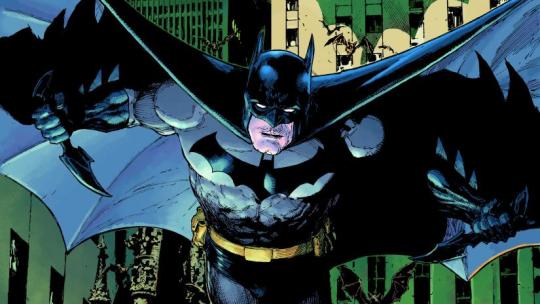
Feature
TV
Movies
John Saavedra
Dec 18, 2019
Batman
DC Entertainment
Scott Snyder
Kevin Conroy
Bruce Timm
Instagram
SDCC
SDCC 2019
Tom King
from Books https://ift.tt/2SsKpdl
0 notes